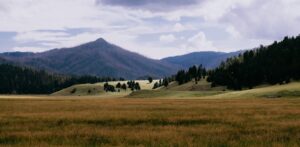
The Valles Caldera National Preserve (VCNP) is one of the country’s greatest public lands heirlooms. Its cultural, ecological, hydrological, and geological attributes are incomparable, and these precious public resources need to be carefully preserved and protected.
VCNP is preparing a General Management Plan to establish long-term direction for resource protection and visitor experiences at the park, as well as high-level concepts to guide future development and facility investments. As VCNP grapples with how to manage an explosion in visitation numbers, the General Management Plan must be the framework to protect the Preserve’s fragile cultural resources, wildlife, watersheds, fisheries, and overall ecology from being adversely impacted by overuse.
Parallel to the general management plan/development concept plan, VCNP is also undertaking wilderness eligibility and wild and scenic river assessments. The outcomes of these assessments will inform the plan. VCNP will also provide the public an opportunity in the future to review and comment on a draft plan, anticipated in the winter of 2024.
Public Comment Period
Members of the public are encouraged to participate in this effort during the current public comment period that ends June 9, 2023. Public input will help the National Park Service refine and improve the initial planning ideas. To provide your input, VCNP asks the public to fill out a (somewhat unwieldy) questionnaire on the official comment page: https://parkplanning.nps.gov/commentForm.cfm?documentID=128878
People are clamoring for more access points, roads, camping, and trails. But more development means greater possible adverse impacts on the Preserve’s fragile cultural and natural resources. As a general rule of thumb, New Mexico Wild recommends stressing the importance of minimizing human impacts to the Preserve. We suggest highlighting the following points in your comments:
- The General Management Plan must be the long-term framework to protect the Preserve’s fragile cultural resources, wildlife, watersheds, fisheries, and overall ecology from being adversely impacted by overuse. The VCNP’s “Initial Planning Ideas” propose an overly impactful level of development, which could have long-term adverse impacts on the ecological and cultural integrity of the Preserve.
- The preservation of key cultural, watershed, and critical wildlife habitats must take precedence over access and use in the plan. The building or improvement of roads, trails, and camping must avoid sensitive areas and resources.
- The Preserve already has an extensive motorized road network. There is no reason to expand motorized access.
- Overall daily and seasonal access and use (both motorized and non-motorized) must stay at levels that minimize adverse impacts. Less is always more. Any and all development has adverse impacts to some degree.
- Increased use demands an increase in both public education and law enforcement. Trespass grazing, poaching, and illegal motorized trespass must be curbed. Having range riders and on-the-ground enforcement officers throughout the Preserve is critical, especially along the Preserve’s northern boundary.
- Trespass cattle have been impacting the Preserve for years, including riparian areas in Valle San Antonio and Valle Jaramillo, and throughout the meadows and critical water sources near the northern boundary of the Preserve. The impacts of trespass cattle on the Preserve’s sensitive watershed and wildlife resources are completely unacceptable, especially as the NPS plans for increased human impacts and visitation. Hiring seasonal range riders to repair fences and push cows out of the Preserve is long overdue. The NPS should work with USFS to require forest service permittees with allotments adjacent to the Preserve to take additional steps to control livestock and ensure they do not enter the Preserve, for example, by implementing virtual fencing systems.
- Conserving large portions of the Preserve by keeping these areas free of motorized and mechanized use (and of high-use hiking trails) is a critical component of the plan. We encourage the NPS to develop an alternative through the NEPA process that would consolidate two or more of the individual Wilderness units into larger, contiguous areas with backcountry zoning. Dividing Wilderness quality lands with corridors of self-guided zoning and improved trails, open to mechanized uses, would have adverse impacts on wildlife behavior and habitat. Providing larger areas of unfragmented Wilderness with backcountry zoning would support wildlife and offset some of the impacts from increased usage and visitation.
- Planning for access and use must carefully consider seasonal wildlife migration, breeding, and other wildlife behavior. Protecting wildlife corridors, breeding areas, and necessary habitat must take precedence over access and use.
Throughout this planning process, it is critical for the NPS to engage in meaningful consultation with affiliated Pueblos and Tribes regarding the array of sensitive and important cultural features of the Preserve’s landscape.
For information about VCNP’s initial planning ideas, visit the project website here:
https://parkplanning.nps.gov/documentsList.cfm?parkID=552&projectID=112511
VCNP has created a story map to explain the preliminary concepts under consideration: https://storymaps.arcgis.com/stories/b92f9517c33548f1b8cfbd1b86c42ef9
Additional maps and information about the preliminary concepts are summarized here.
If you have any questions about the VCNP’s Planning Process and/or filling out the comment form, please feel free to contact us!
Garrett VeneKlasen, Northern Conservation Director – garrett@nmwild.org

